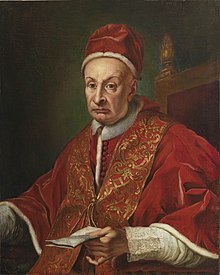Benedict XIII | |||||||||||||||||||||||
|---|---|---|---|---|---|---|---|---|---|---|---|---|---|---|---|---|---|---|---|---|---|---|---|
| Bishop of Rome | |||||||||||||||||||||||
 | |||||||||||||||||||||||
| Church | Catholic Church | ||||||||||||||||||||||
| Papacy began | 29 May 1724 | ||||||||||||||||||||||
| Papacy ended | 21 February 1730 | ||||||||||||||||||||||
| Predecessor | Innocent XIII | ||||||||||||||||||||||
| Successor | Clement XII | ||||||||||||||||||||||
| Previous post(s) |
| ||||||||||||||||||||||
| Orders | |||||||||||||||||||||||
| Ordination | 24 February 1671 by Clement X | ||||||||||||||||||||||
| Consecration | 3 February 1675 by Paluzzo Paluzzi Altieri Degli Albertoni | ||||||||||||||||||||||
| Created cardinal | 22 February 1672 by Clement X | ||||||||||||||||||||||
| Personal details | |||||||||||||||||||||||
| Born | Pietro Francesco Orsini 2 February 1649[1] | ||||||||||||||||||||||
| Died | 21 February 1730 (aged 81) Rome, Papal States | ||||||||||||||||||||||
| Coat of arms |  | ||||||||||||||||||||||
Ordination history | |||||||||||||||||||||||
| |||||||||||||||||||||||
| |||||||||||||||||||||||
| Other popes named Benedict | |||||||||||||||||||||||
Pope Benedict XIII (Latin: Benedictus XIII; Italian: Benedetto XIII; 2 February 1649 – 21 February 1730), born Pietro Francesco Orsini and later called Vincenzo Maria Orsini, was head of the Catholic Church and ruler of the Papal States from 29 May 1724 to his death in February 1730.[2]
A Dominican friar, Orsini focused on his religious responsibilities as bishop rather than on papal administration. Orsini's lack of political expertise led him to increasingly rely on an unscrupulous secretary (Cardinal Niccolò Coscia) whose financial abuses ruined the papal treasury, causing great damage to the Church in Rome.
In the process towards sainthood, his cause for canonization opened in 1755, but it was closed shortly afterwards. It was reopened on 21 February 1931, but it was closed once again in 1940. It was opened once more on 17 January 2004, with the official process commencing in 2012 and concluding later in 2017. He now has the posthumous title of Servant of God.
- ^ Wikisource:Catholic Encyclopedia (1913)/Pope Benedict XIII
- ^ Pope Benedict X is now considered an antipope. At the time, however, this status was not recognized; therefore, the man whom the Catholic Church officially considers to be the tenth true Pope Benedict took the official number XI, rather than X. This has advanced the numbering of all subsequent Popes Benedict by one. Popes Benedict XI–XVI are, from an official point of view, the tenth through fifteenth popes by that name.